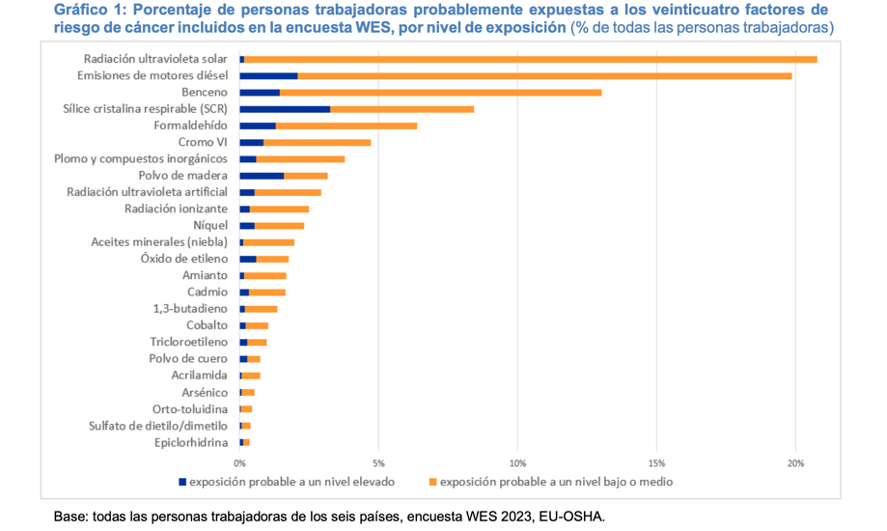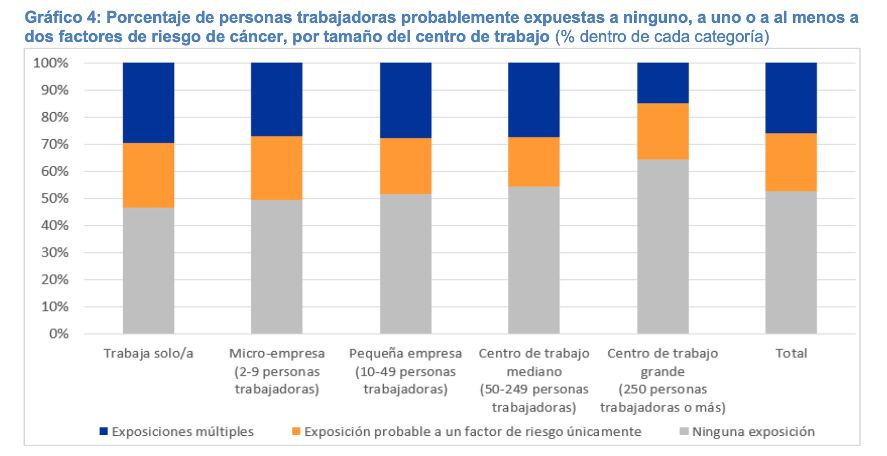Cancer. First cause of work-related death. Analysis

In 2022, there were an estimated 20 million new cases of cancer with 9.7 million deaths (approximately 1 in 9 men and 1 in 12 women). Around 1 in 5 people will develop cancer during their lifetime.
The most frequent occupational exposures, among the twenty-four cancer risk factors considered in the survey, were: solar ultraviolet (UV) radiation, diesel engine emissions, benzene, respirable crystalline silica and formaldehyde, followed by hexavalent chromium, lead and its inorganic compounds, and wood dust.
According to new estimates available in the IARC Global Cancer Observatory, lung cancer was the most common cancer worldwide with 2.5 million new cases, accounting for 12.41% of total new cases. Female breast cancer ranked second (2.3 million cases; 11.61% of total new cases), followed by colorectal cancer (1.9 million cases; 9.61% of total cases), prostate cancer (1.5 million cases; 7.31% of total cases) and stomach cancer (970 000 cases; 4.91% of total cases).
In 2050, more than 35 million new cases of cancer are expected, which represents an increase of 77% compared to the 20 million cases estimated in 2022, according to the World Health Organization. The rapid growth in the global cancer burden reflects both population ageing and growth, as well as changes in people's exposure to risk factors, several of which are associated with socioeconomic development. Tobacco, alcohol and obesity are key drivers of increasing cancer incidence, while air pollution remains a major environmental risk factor.
Occupational cancer in Spain. Current situation and legal framework
In 2023, there were 279,260 new cancer diagnoses in Spain, of which the most recent scientific evidence indicates that 5.3 percent are due to exposure to carcinogenic agents in the workplace. According to the report 'Occupational cancer, a silenced epidemic', prepared by the Secretariat of Occupational Health and Environmental Sustainability of CCOO on the occasion of World Cancer Day
However, last year only 94 reports of occupational diseases due to exposure to carcinogens were registered, which demonstrates the enormous problem of underreporting in the system. All this despite the elaborate legal framework in this area:
- ROYAL DECREE 665/1997, of May 12, on the protection of workers against risks related to exposure to carcinogenic agents during work
- ROYAL DECREE 1299/2006, of November 10, approving the list of occupational diseases in the Social Security system and establishing criteria for their notification and registrationGroup I, IV, V, VI
- Technical guide for the assessment and prevention of risks related to exposure to asbestos
- Technical guide for the assessment and prevention of risks related to chemical agents 2022
- Technical guide for the assessment and prevention of risks related to exposure to carcinogenic or mutagenic agents at work 2022
The cancer of the European workplace.
Cancer is the leading cause of death at work in Europe. Although it is a multi-causal disease, it is estimated that 301% of all cancers are caused by work (INSST).
The EU Strategic Framework on Safety and Health at Work for the period 2021-27 states that the 52% of work-related deaths in Europe are due to cancer. This figure highlights the need to develop action against occupational cancer that integrates different areas of knowledge, including epidemiological and clinical knowledge.
The Strategic Framework takes a tripartite approach (involving EU institutions, Member States, social partners and other stakeholders) and focuses on three key priorities: anticipating and managing change in the context of the green, digital and demographic transitions; improving the prevention of work-related accidents and diseases and striving for a Vision Zero approach to work-related deaths; and increasing preparedness to respond to current and future health crises.
The European Agency for Safety and Health at Work (EU-OSHA) has carried out a wide-ranging survey among working people, the Survey on exposure of workers to cancer risk factors in Europe (WES) survey in six EU Member States: Germany, Ireland, Spain, France, Hungary and Finland. The WES estimates the probability of workers' exposure during the last working week to 24 known cancer risk factors, including industrial chemicals, process-generated substances and mixtures, and physical risk factors.
The most frequent occupational exposures, among the twenty-four cancer risk factors considered in the survey, were: solar ultraviolet (UV) radiation, diesel engine emissions, benzene, respirable crystalline silica and formaldehyde, followed by hexavalent chromium, lead and its inorganic compounds, and wood dust. Respirable crystalline silica, diesel engine emissions and wood dust stand out for the highest proportions of workers likely to be exposed to these risk factors at high levels.

When comparing exposure versus non-exposure, workers in micro- or small-sized businesses (with fewer than fifty people) were 1.3 times more likely to be exposed to one or more cancer risk factors than staff in medium- or large-sized workplaces.

EU-OSHA.
EU Strategic Framework on Health and Safety at work 2021-2027
EU OSHA workers exposure survey on cancer risk https://osha.europa.eu/en/facts-and-figures/workers-exposure-survey-cancer-risk-factors-europe
International Agency for Research On Cancer (World Health Organization) https://gco.iarc.fr/en
By Susana Romero


